Song birds enter the morning

Western Meadowlark (Sturnella neglec), Malheur National Wildlife Refuge, Oregon. An abundant and familiar bird of open country across the western two-thirds of the continent, the Western Meadowlark is known for its melodic song. It is frequently seen singing along roadsides in native grassland and agricultural areas. Meadowlarks are common along roadsides near Malheur National Wildlife Refuge in southeast Oregon.: photo by Dan Dzurisin, 15 April 2007
Joseph Ceravolo: March 1988
Song birds enter the morning
the pre-dawn before the fires
you know, when the night
.......................floats away
like a vapor on a lake.
or like kisses in the woods.
Songs that even God didn't know,
or even the gods learned
..............from their created.
Continuous, threaded, like a
........cherry stuck in
the throat
Joseph Ceravolo (1934-1988): March 1988, from Collected Poems, 2012
Joseph Ceravolo (1934-1988): March 1988, from Collected Poems, 2012

Western Meadowlark (Sturnella neglec), Malheur National Wildlife Refuge, Oregon. An abundant and familiar bird of open country across the western two-thirds of the continent, the Western Meadowlark is known for its melodic song. It is frequently seen singing along roadsides in native grassland and agricultural areas. Meadowlarks are common along roadsides near Malheur National Wildlife Refuge in southeast Oregon.: photo by Dan Dzurisin, 15 April 2007
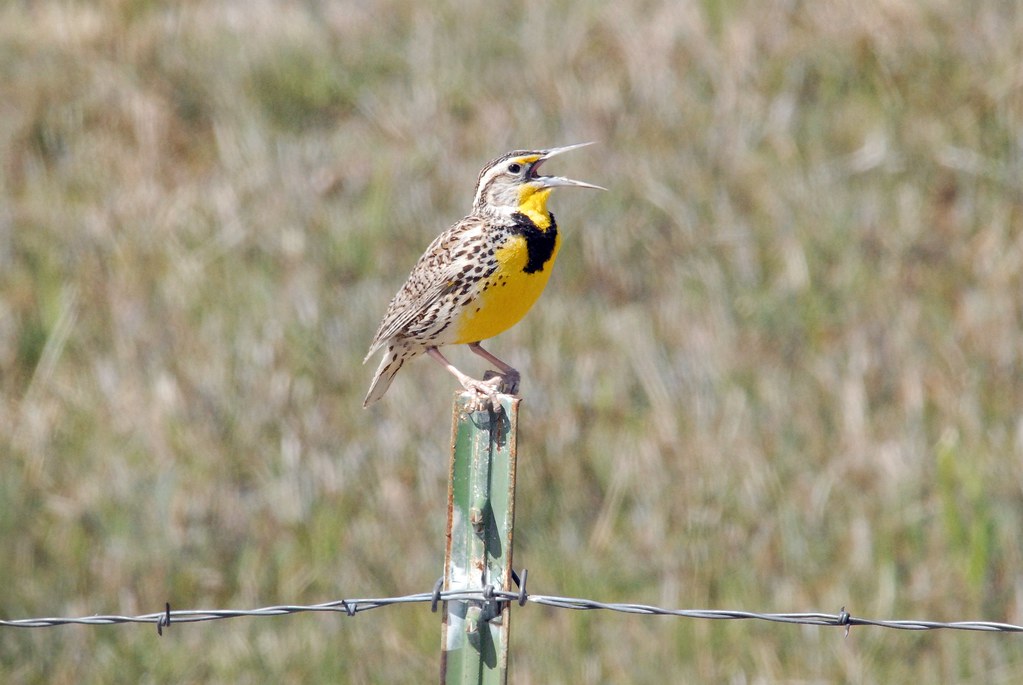
Western Meadowlark (Sturnella neglec), Malheur National Wildlife Refuge, Oregon. An abundant and familiar bird of open country across the western two-thirds of the continent, the Western Meadowlark is known for its melodic song. It is frequently seen singing along roadsides in native grassland and agricultural areas. Meadowlarks are common along roadsides near Malheur National Wildlife Refuge in southeast Oregon.: photo by Dan Dzurisin, 15 April 2007

White-faced Ibis (Plegadis chihi), Malheur National Wildlife Refuge, Oregon. The White-faced Ibis, a dark wading bird with a long, down-curved bill, breeds across the western United States northward to Montana, eastward to western Louisiana, and southward to South America. Ibis and other shore birds are numerous during spring migrations at Malheur National Wildlife Refuge in southeast Oregon.: photo by Dan Dzurisin, 15 April 2007
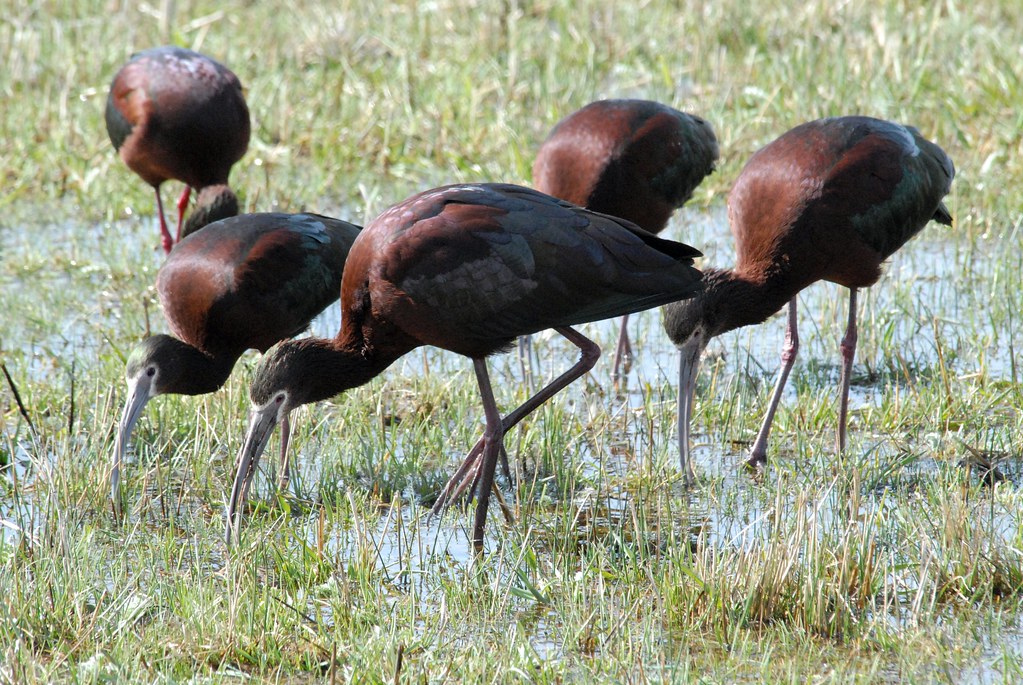
White-faced Ibis (Plegadis chihi), Malheur National Wildlife Refuge, Oregon. The White-faced Ibis, a dark wading bird with a long, down-curved bill, breeds across the western United States northward to Montana, eastward to western Louisiana, and southward to South America. Ibis and other shore birds are numerous during spring migrations at Malheur National Wildlife Refuge in southeast Oregon.: photo by Dan Dzurisin, 15 April 2007

Long-billed Curlew, Malheur National Wildlife Refuge, Oregon. North America's largest shore bird, the Long-billed Curlew breeds in the grasslands of the Great Plains and Great Basin. Curlews and other shore birds are numerous during spring migrations at Malheur National Wildlife Refuge in southeast Oregon.: photo by Dan Dzurisin, 15 April 2007
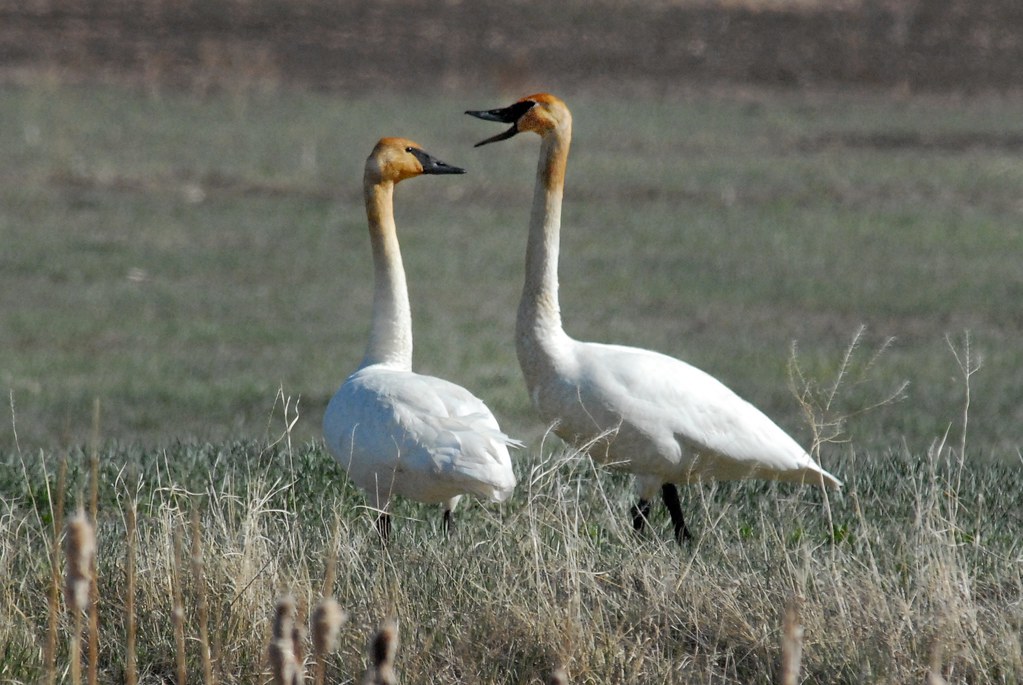
Tundra Swans (Cygnus columbianus), Malheur National
Wildlife Refuge, Oregon. True to its name, the Tundra
Swan breeds in the high tundra across the top of North America. It
winters in large flocks across both coasts, and is frequently
encountered during its migration across the continent, This pair was
photographed in the southern part of Malheur National
Wildlife Refuge in April 2007.: photo by Dan Dzurisin, 15 April 2007
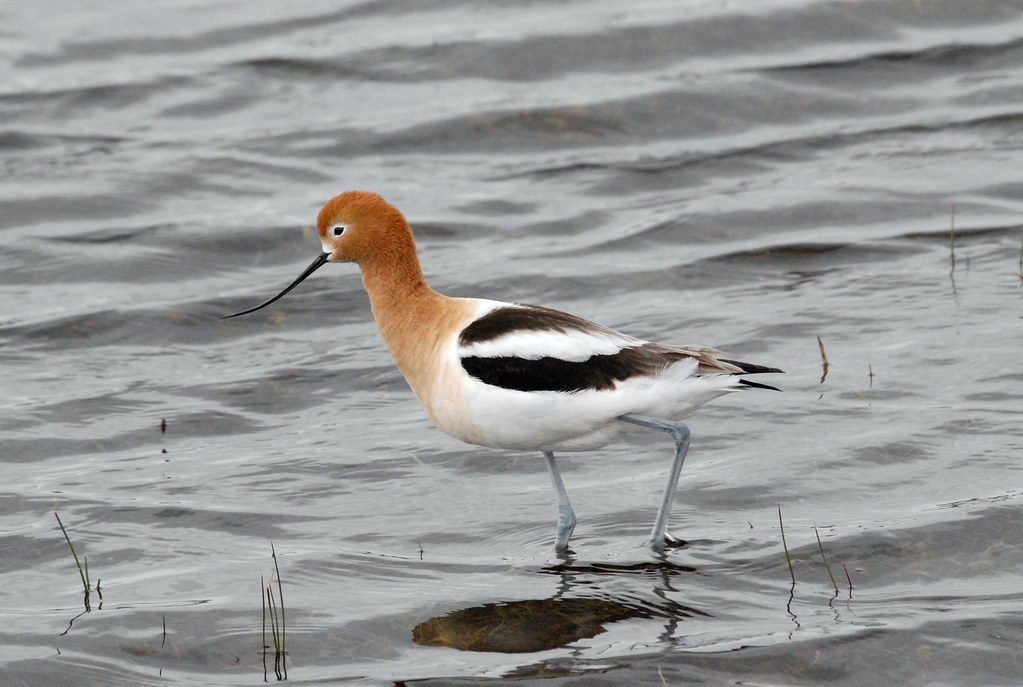
American Avocet (Recurvirostra americana), Malheur National
Wildlife Refuge, Oregon. With its elegant profile and striking coloration, the American Avocet is unique among North American birds.
In summer it can be found in temporary and unpredictable wetlands
across western North America, where it swings its long upturned bill
through shallow water to catch small invertebrates.: photo by Dan Dzurisin, 15 April 2007
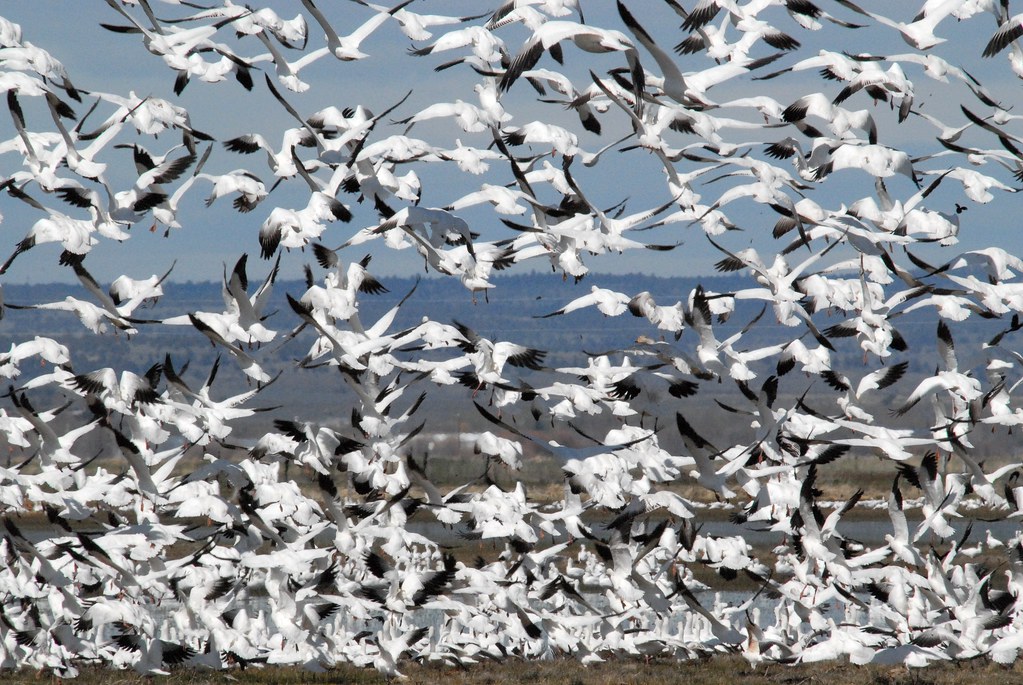
Ross'
Geese (Chen rossii), Malheur National
Wildlife Refuge, Oregon. A tiny white goose with black wingtips, the
Ross' Goose is like a miniature version of the more abundant Snow Goose.
The Ross' Goose breeds in the central Arctic and winters in central California. During spring migration, thousands of Ross' Geese transit Malheur National
Wildlife Refuge and flooded agricultural fields nearby.: photo by Dan Dzurisin, 15 April 2007
in a lake risen from a volcano
Indonesia’s Mount Sinabung volcano spews lava and ash during an
eruption as it is seen from Tiga Pancur village in Karo, North Sumatra
province: photo by Rony Muharrman/Reuters, 8 January 2016
Joseph Ceravolo: March 7, 1988
Swamps and people live in a lake
risen from a volcano
An island bolted from fire
appears out of the sea like
A memory appearing in the shadow
of dark yearnings.
Who can appear to me?
Joseph Ceravolo (1934-1988): March 7, 1988, from Collected Poems, 2012
Ekrem Turkmen poses for a portrait in his store selling Ottoman Traditional clothing inside the Istanbul Grand Bazaar in Istanbul, Turkey. Istanbul’s Grand Bazaar is one of the oldest covered markets in the world and hosts more than 3,000 stores. It is estimated that more than 250,000 people visit the bazaar each day : photo by Chris McGrath via FT Photo Diary, 8 January 2016
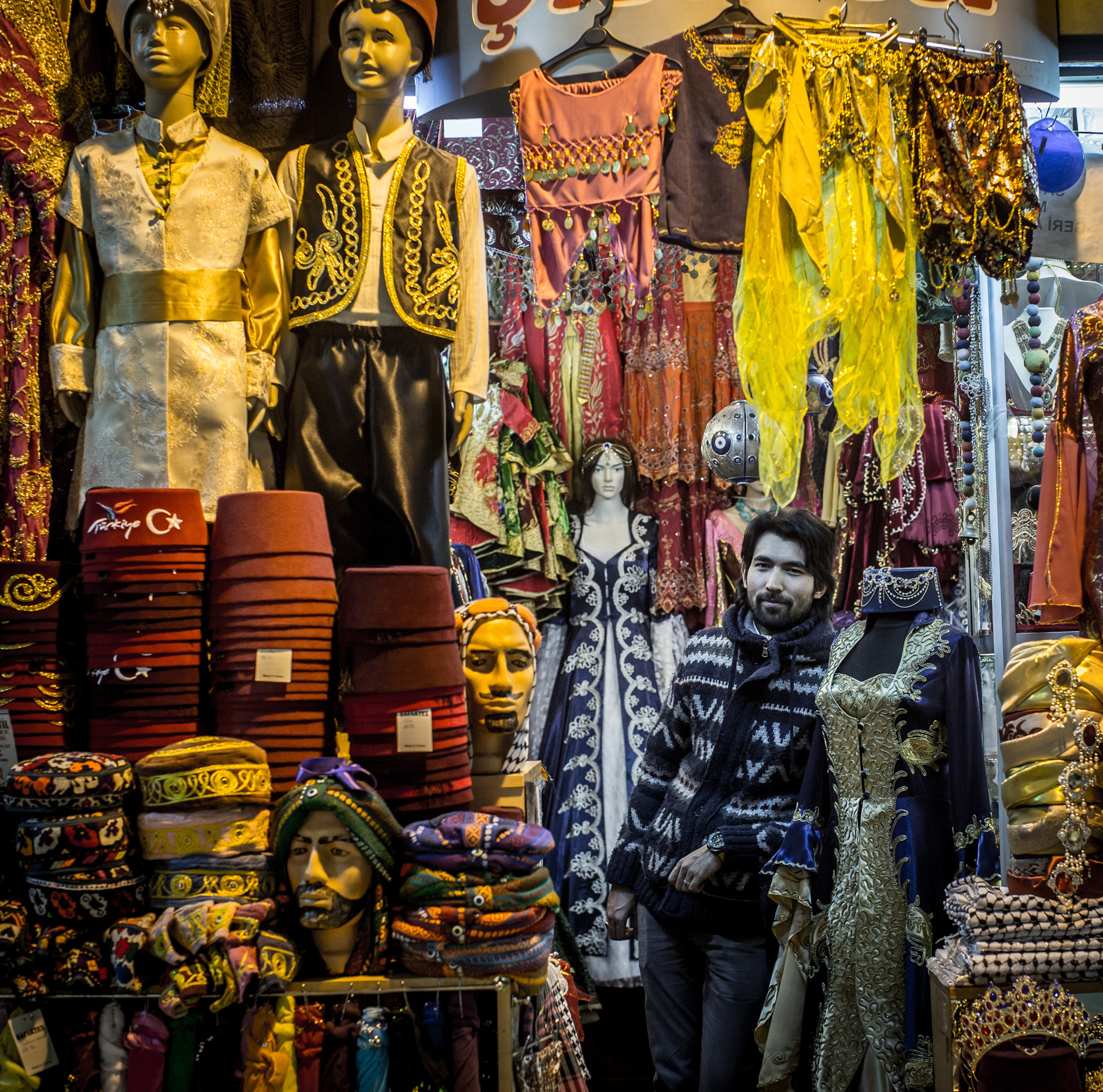
.
Ekrem Turkmen poses for a portrait in his store selling Ottoman Traditional clothing inside the Istanbul Grand Bazaar in Istanbul, Turkey. Istanbul’s Grand Bazaar is one of the oldest covered markets in the world and hosts more than 3,000 stores. It is estimated that more than 250,000 people visit the bazaar each day : photo by Chris McGrath via FT Photo Diary, 8 January 2015
in the hour of the street
A Palestinian protester walks past burning tyres during clashes with
Israeli security forces following a demonstration against the
expropriation of Palestinian land by Israel, on in the village of Kafr
Qaddum: photo by Jaafar Ashtiyeh/AFP, 8 January 2015
All the stars will be gone,
there is enough emptiness in space
to absorb all dust of stars,
while you and I speak under voice
of birds, sleep, mist
at the hour of the street.
Nobody is loitering, O sensual eyes
just see or connect the dreamers
and as our generation's blood spills,
the water of night is flooding us.
Nobody's holding anybody's wrist
nobody's humming nobody's singing
in the hour of the street.
Joseph Ceravolo (1934-1988): January 1988, from Collected Poems, 2012
A Yemeni inspects a vehicle destroyed by airstrikes allegedly carried out by the Saudi-led coalition in Sana’a. Airstrikes by the Saudi-led coalition have intensified since the humanitarian ceasefire in Yemen ended: photo by Yahya Arhab/EPA, 8 January 2016
Migrants and refugees walk on Friday after crossing the Macedonian border in the Serbian village of Miratovac. Migrants and refugees are facing deteriorating weather conditions as they make their way to the EU via the Balkans: photo by Armend Nimani/AFP 8 January 2016
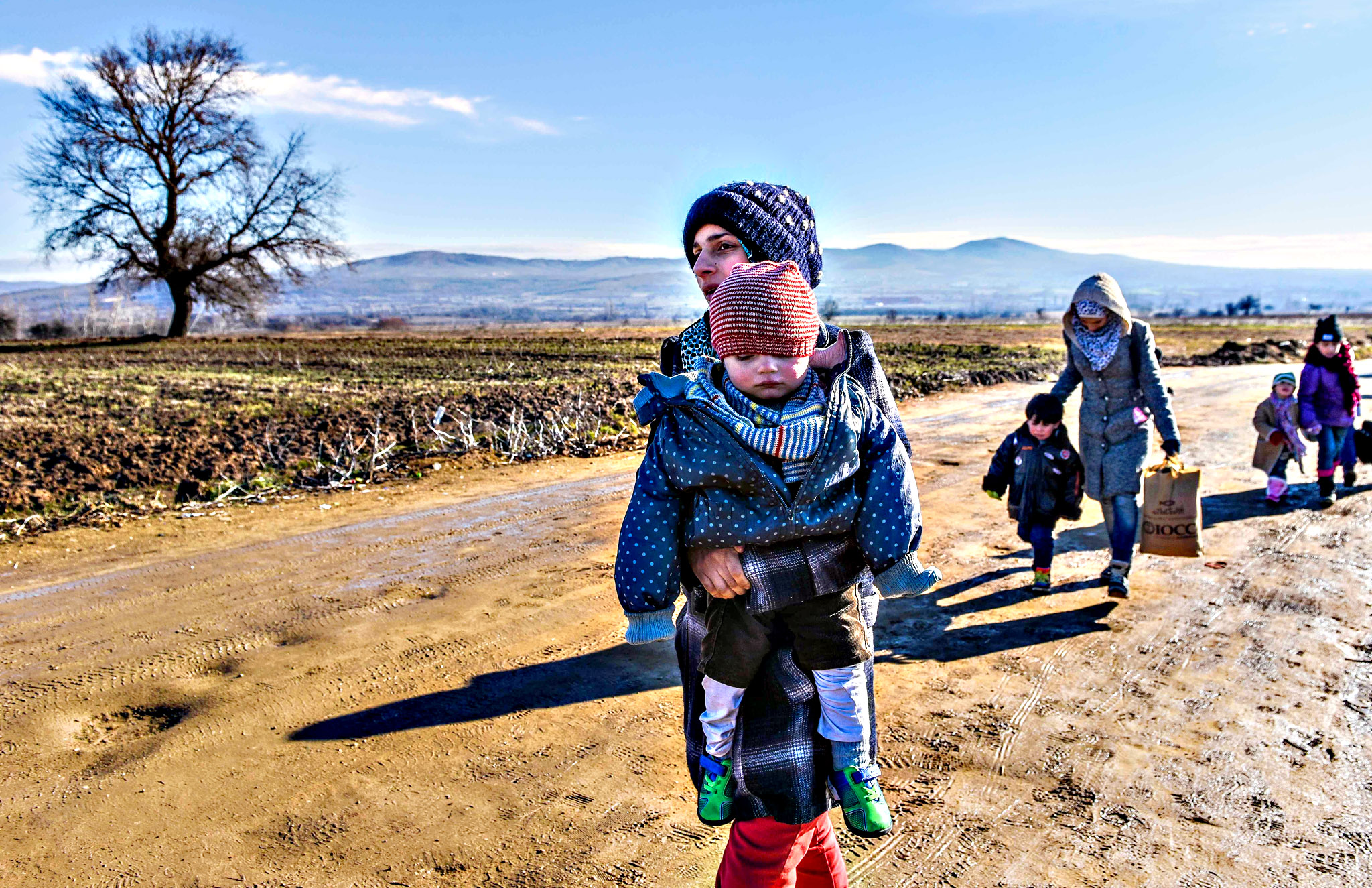
Migrants and refugees walk on Friday after crossing the Macedonian border in the Serbian village of Miratovac. Migrants and refugees are facing deteriorating weather conditions as they make their way to the EU via the Balkans: photo by Armend Nimani/AFP 8 January 2016
An Iranian woman holds up a poster showing Sheikh Nimr al-Nimr, a prominent opposition Saudi Shia cleric who was executed last week by Saudi Arabia, in Tehran, Iran: photo by Vahid Salemi/AP, 4 January 2016

An Iranian woman holds up a poster showing Sheikh Nimr al-Nimr, a prominent opposition Saudi Shia cleric who was executed last week by Saudi Arabia, in Tehran, Iran: photo by Vahid Salemi/AP, 4 January 2016
Shia Muslims shout slogans during a protest against the execution of cleric Nimr al-Nimr, who was executed along with others in Saudi Arabia, on the outskirts of Srinagar, India on Friday ended: photo by Danish Ismail/Reuters, 8 January 2016

Shia Muslims shout slogans during a protest against the execution of cleric Nimr al-Nimr, who was executed along with others in Saudi Arabia, on the outskirts of Srinagar, India on Friday ended: photo by Danish Ismail/Reuters, 8 January 2016
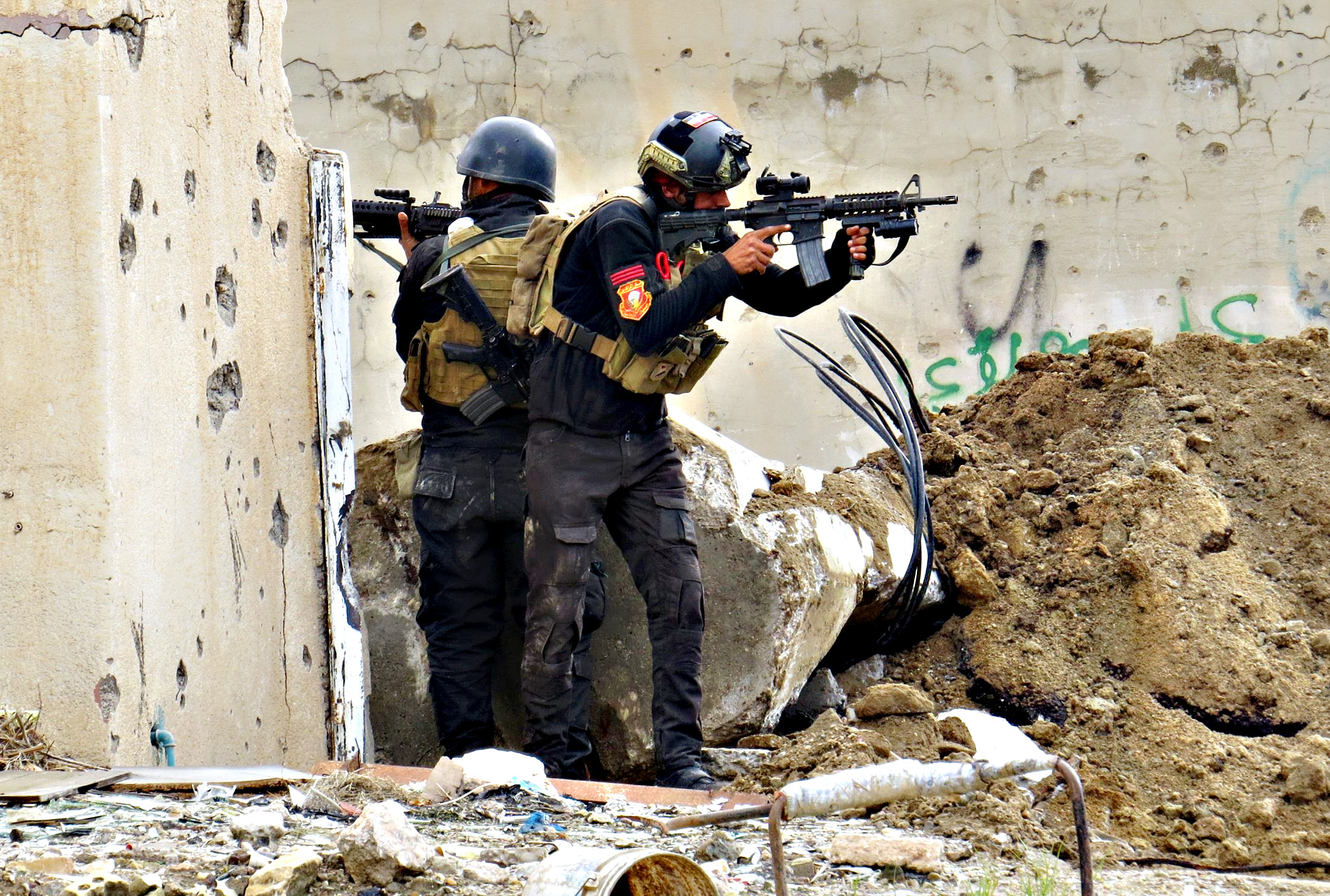
Iraqi forces secure an area near the Grand Mosque in central Ramadi,
the capital of Iraq’s Anbar province, on Friday, after retaking the city
from Islamic State (IS) group jihadists: photo by AFP, 8 January 2016

Iraqi forces secure an area near the Grand Mosque in central Ramadi, the capital of Iraq’s Anbar province, on Friday, after retaking the city from Islamic State (IS) group jihadists: photo by AFP, 8 January 2016

Iraqi forces secure an area near the Grand Mosque in central Ramadi, the capital of Iraq’s Anbar province, on Friday, after retaking the city from Islamic State (IS) group jihadists: photo by AFP, 8 January 2016
A customer asks for the price of a bittergourd at Duri market on a railway track in Jakarta, on Friday: photo by Beawiharta/Reuters, 8 January 2016
A customer asks for the price of a bittergourd at Duri market on a railway track in Jakarta, on Friday: photo by Beawiharta/Reuters, 8 January 2016
Supporters of U.S. Republican presidential candidate Donald Trump
jeer at protesters during a campaign rally in Burlington, Vermont : photo by Erin Siegal/Reuters, 8 January 2016
Refuge
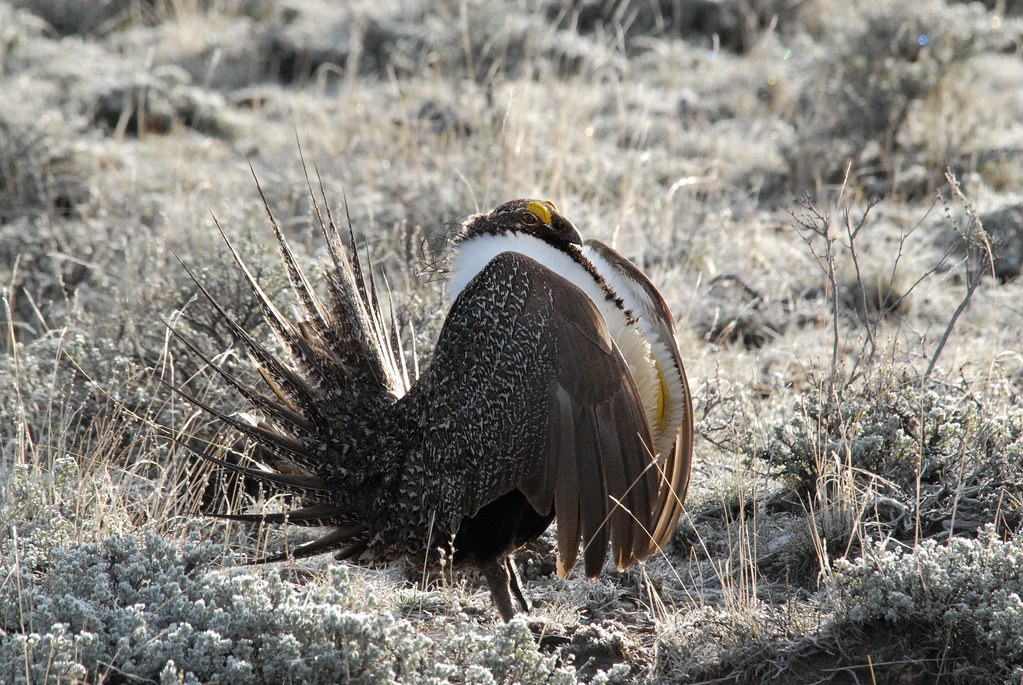
Greater
Sage-Grouse (Centrocercus urophasianus), male, Malheur National
Wildlife Refuge. A bird of the open sagebrush plains, the Greater
Sage-Grouse is the largest grouse species in North America. As in many
other grouse species, the male plays no role in the raising of the
young. Males display on dancing grounds known as leks. Females visit the
leks to mate, then go off to raise their brood by themselves.
Traditional lekking grounds may be used for decades. Although many male Greater Sage-Grouse may display at a lek, only one or two males get picked by a majority of females for mating. We observed a lek with about 15 males displaying for two females on two consecutive mornings in April: photo by Dan Dzurisin, April 2007
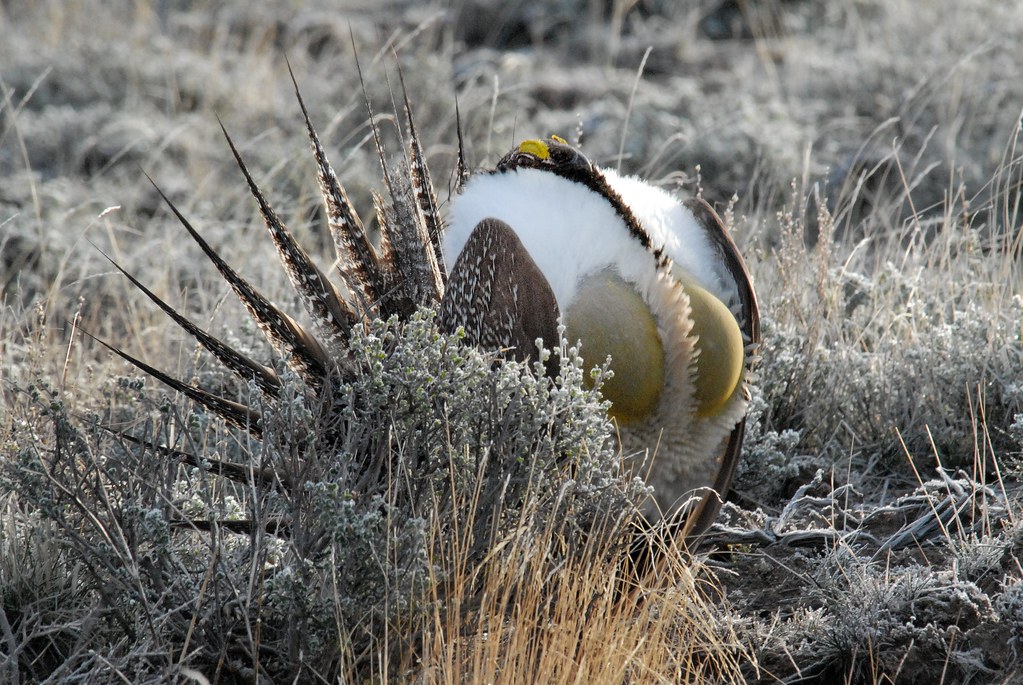
Greater Sage-Grouse (Centrocercus urophasianus), male, Malheur National Wildlife Refuge. A bird of the open sagebrush plains, the Greater Sage-Grouse is the largest grouse species in North America. As in many other grouse species, the male plays no role in the raising of the young. Males display on dancing grounds known as leks. Females visit the leks to mate, then go off to raise their brood by themselves. Traditional lekking grounds may be used for decades. Although many male Greater Sage-Grouse may display at a lek, only one or two males get picked by a majority of females for mating. We observed a lek with about 15 males displaying for two females on two consecutive mornings in April: photo by Dan Dzurisin, April 2007
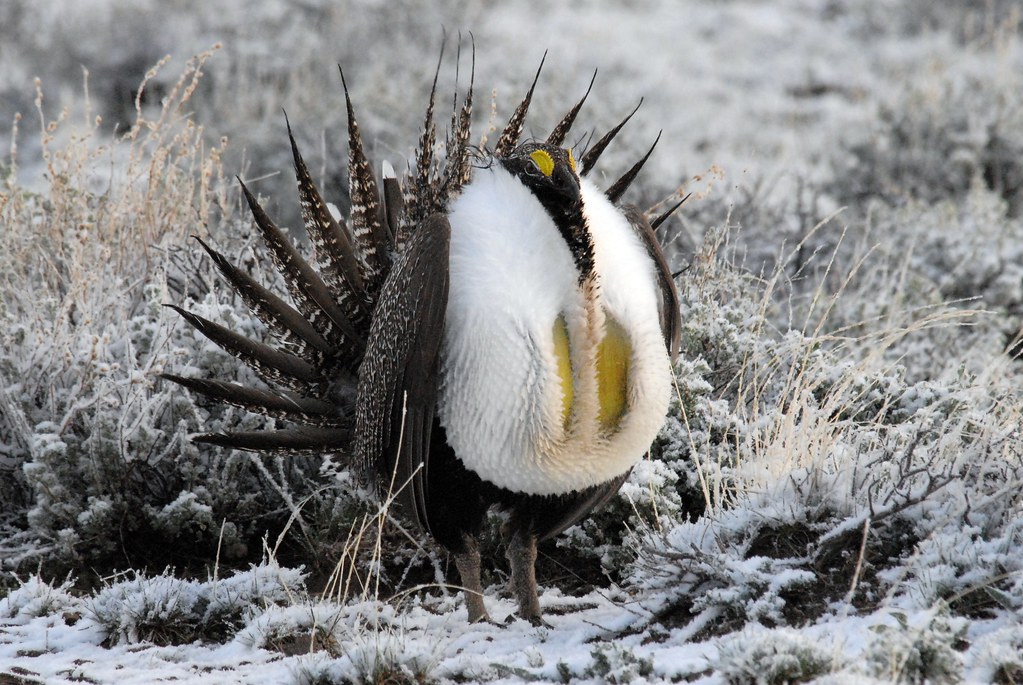
Greater Sage-Grouse (Centrocercus urophasianus), male, Malheur National Wildlife Refuge. A bird of the open sagebrush plains, the Greater Sage-Grouse is the largest grouse species in North America. As in many other grouse species, the male plays no role in the raising of the young. Males display on dancing grounds known as leks. Females visit the leks to mate, then go off to raise their brood by themselves. Traditional lekking grounds may be used for decades. Although many male Greater Sage-Grouse may display at a lek, only one or two males get picked by a majority of females for mating. We observed a lek with about 15 males displaying for two females on two consecutive mornings in April: photo by Dan Dzurisin, April 2007
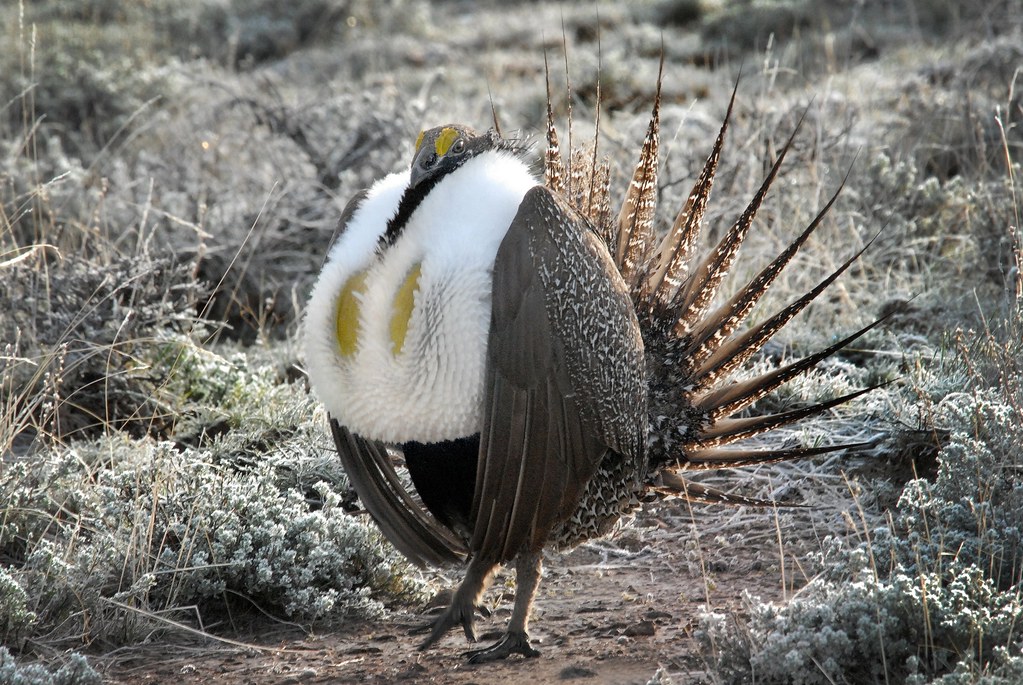
Greater
Sage-Grouse (Centrocercus urophasianus), male, Malheur National
Wildlife Refuge. A bird of the open sagebrush plains, the Greater
Sage-Grouse is the largest grouse species in North America. As in many
other grouse species, the male plays no role in the raising of the
young. Males display on dancing grounds known as leks. Females visit the
leks to mate, then go off to raise their brood by themselves.
Traditional lekking grounds may be used for decades. Although many male Greater Sage-Grouse may display at a lek, only one or two males get picked by a majority of females for mating. We observed a lek with about 15 males displaying for two females on two consecutive mornings in April: photo by Dan Dzurisin, April 2007
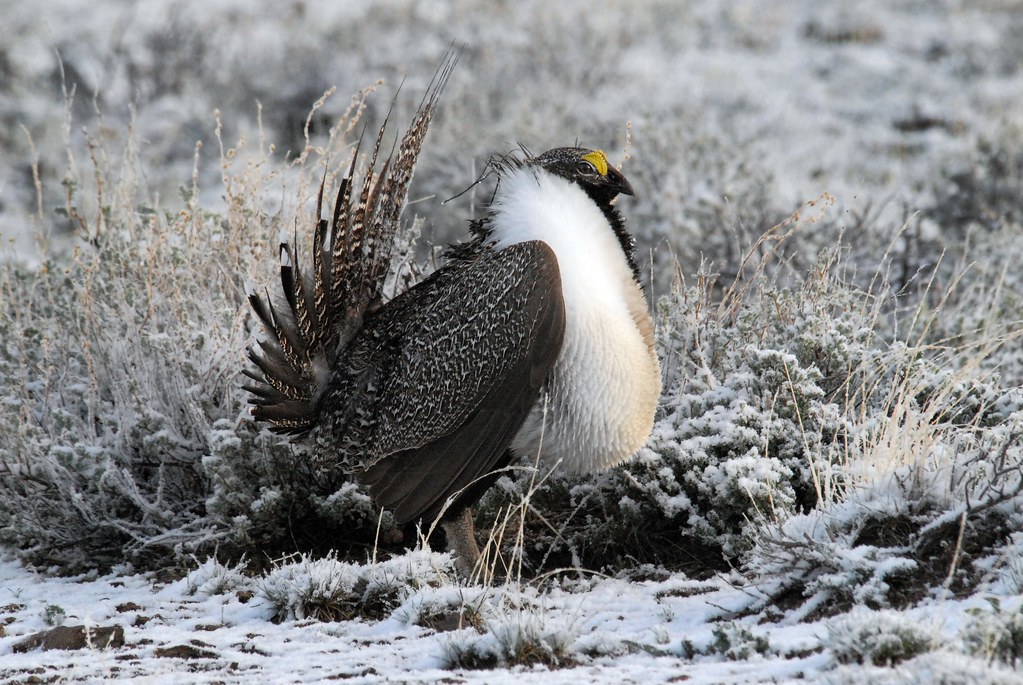
Greater Sage-Grouse (Centrocercus urophasianus), male, Malheur National Wildlife Refuge. A bird of the open sagebrush plains, the Greater Sage-Grouse is the largest grouse species in North America. As in many other grouse species, the male plays no role in the raising of the young. Males display on dancing grounds known as leks. Females visit the leks to mate, then go off to raise their brood by themselves. Traditional lekking grounds may be used for decades. Although many male Greater Sage-Grouse may display at a lek, only one or two males get picked by a majority of females for mating. We observed a lek with about 15 males displaying for two females on two consecutive mornings in April: photo by Dan Dzurisin, April 2007
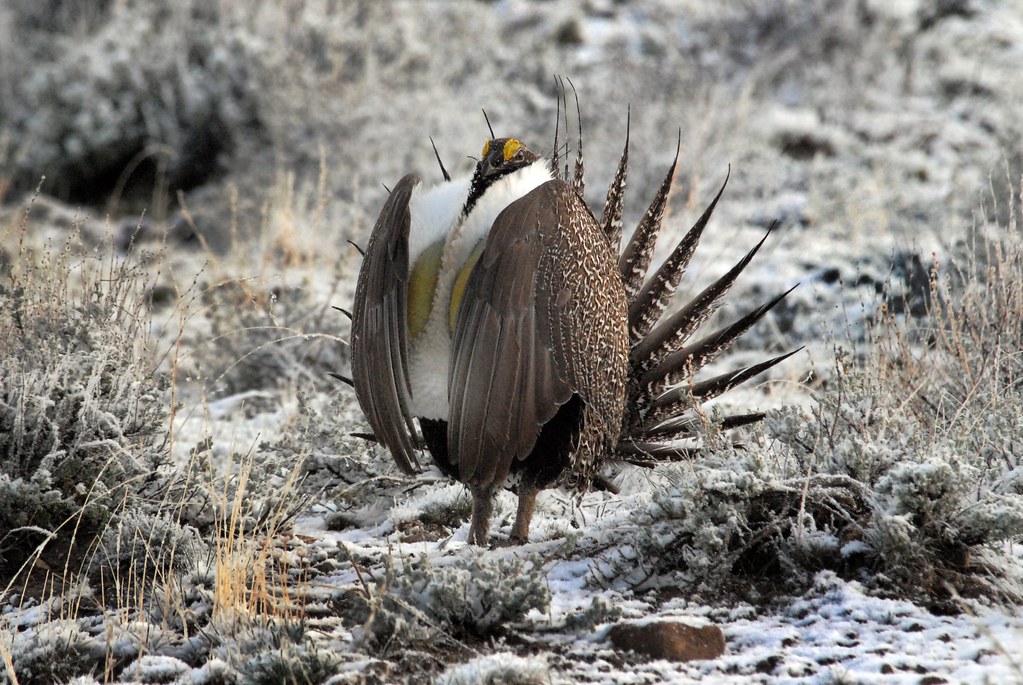
Greater Sage-Grouse (Centrocercus urophasianus), male, Malheur National Wildlife Refuge. A bird of the open sagebrush plains, the Greater Sage-Grouse is the largest grouse species in North America. As in many other grouse species, the male plays no role in the raising of the young. Males display on dancing grounds known as leks. Females visit the leks to mate, then go off to raise their brood by themselves. Traditional lekking grounds may be used for decades. Although many male Greater Sage-Grouse may display at a lek, only one or two males get picked by a majority of females for mating. We observed a lek with about 15 males displaying for two females on two consecutive mornings in April: photo by Dan Dzurisin, April 2007
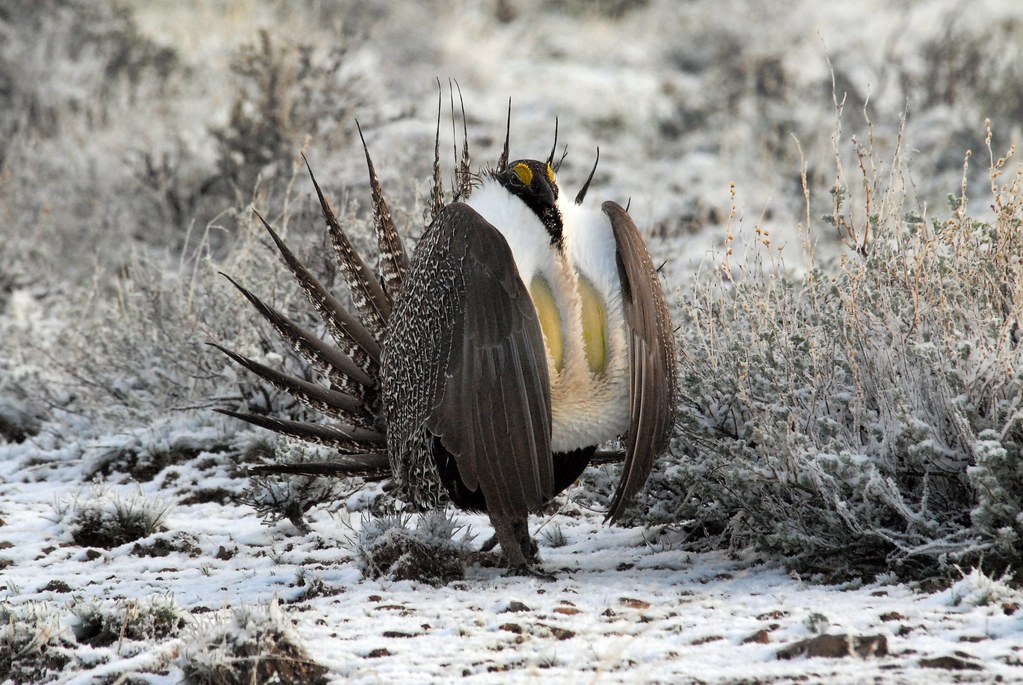
Greater Sage-Grouse (Centrocercus urophasianus), male, Malheur National Wildlife Refuge. A bird of the open sagebrush plains, the Greater Sage-Grouse is the largest grouse species in North America. As in many other grouse species, the male plays no role in the raising of the young. Males display on dancing grounds known as leks. Females visit the leks to mate, then go off to raise their brood by themselves. Traditional lekking grounds may be used for decades. Although many male Greater Sage-Grouse may display at a lek, only one or two males get picked by a majority of females for mating. We observed a lek with about 15 males displaying for two females on two consecutive mornings in April: photo by Dan Dzurisin, April 2007
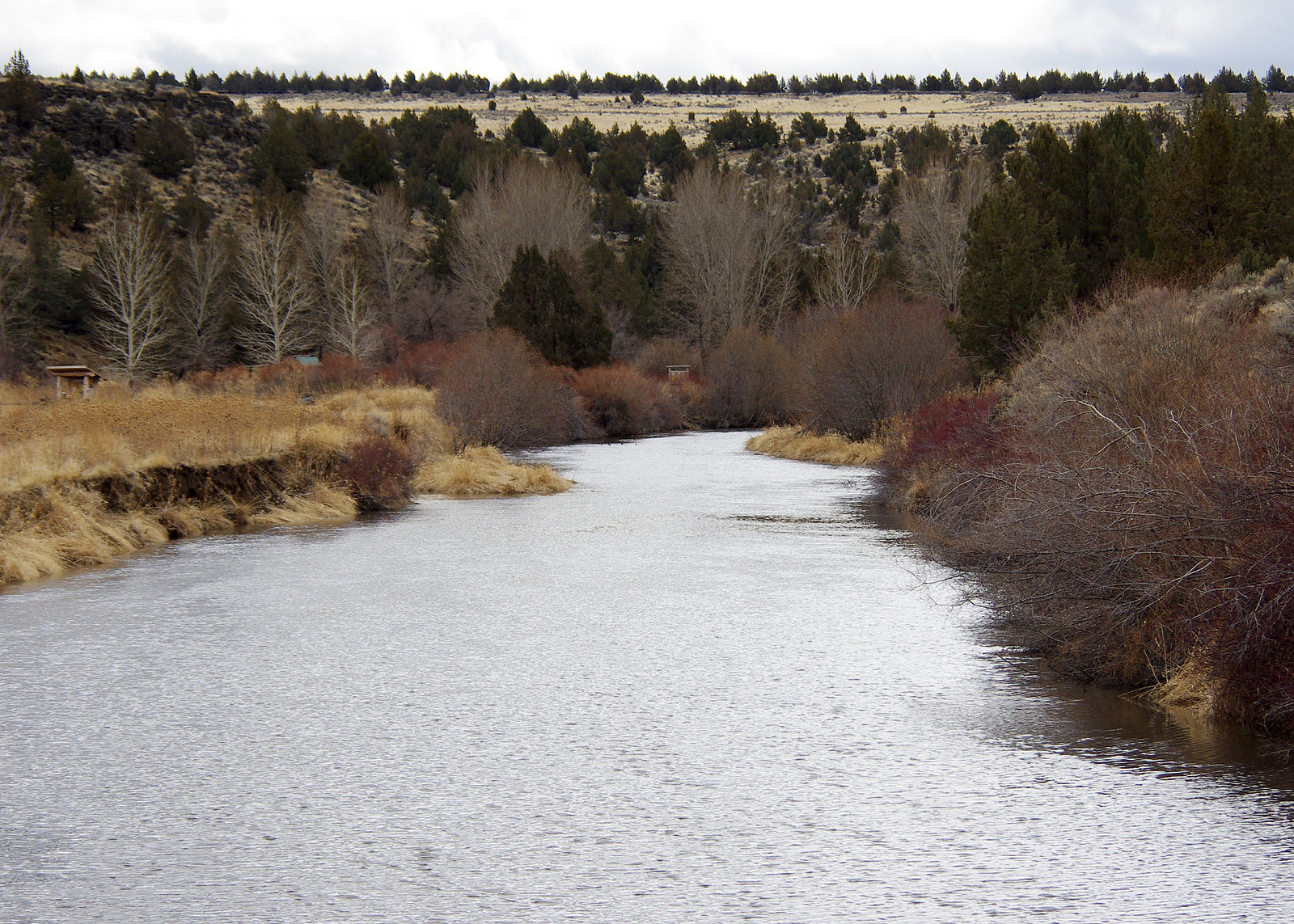
The Donner and Blitzen River in the Oregon high desert
drains the southern portion of Harney Basin, from roughly 20 to 80
miles south-southeast of Burns including the Malheur National Wildlife
Refuge: photo by Martyne Reesman, Oregon Department of Fish and Wildlife, 15 March 2012
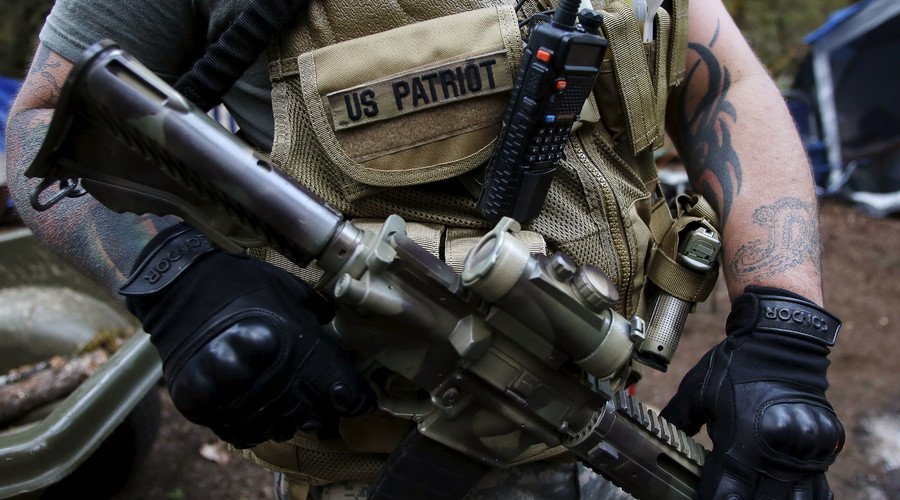
DEVELOPING: #AmmonBundy militia takeover sparked by Hammonds’ “unconstitutional” sentencing: image via RT Verified account @RT_com, 2 January 2015
What will happen if the Oregon militia gets its demands? Kate Galbraith in San Francisco and Sarah Gilman in Portland for The Guardian, 8 January 2016
Allowing cattle to graze across swathes of federal land in Oregon, as an armed band of militia is demanding, could have devastating consequences for the area’s delicate ecosystem, experts have warned.
Rare species such as the greater sage grouse that does a mating dance on federal land adjacent to the Malheur national wildlife refuge, occupied by the militia, have already been harmed by widespread cattle grazing on high-desert plains across the west.
The armed militia is occupying federal land in Oregon that contains swathes of marshland, an unusual feature amid the high desert of southeastern Oregon.
It offers protection for waterfowl across its 188,000 acres, an area nearly half the size of the sprawling city of Los Angeles.
The militia, a ragtag group whose leader, Ammon Bundy, comes from a Nevada family with a history of defying federal land-use rules, has a hazy wish list that includes the release of two Oregon men, imprisoned and convicted of arson. But one of their broadest demands is to transfer more federal land to private ownership in the area.
Such a change could mean a “scorched-earth” situation for wildlife, said Dale Goble, a professor and land-use expert at the University of Idaho’s College of Law, who had gone birding in the refuge.
“If you’ve driven through the high desert of eastern Oregon, the distinction between private and federal [land] is often strikingly clear,” he said. Were the land to be transferred to private ownership, “the marshes and everything that attracts the migratory bird species -- probably, my guess would be, used for irrigation”.
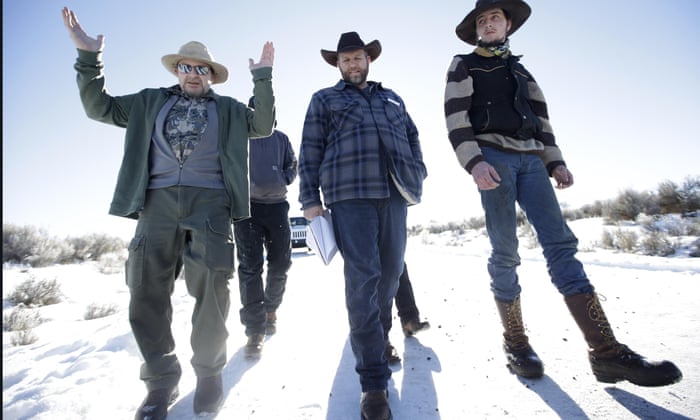
The armed militia are
occupying federal land in Oregon that contains swathes marshland, an
unusual feature amid the high desert of southeastern Oregon: photo by Rick Bowmer/AP, 8 January 2016
The federal Fish and Wildlife
Service, which oversees federal endangered and threatened species,
manages the Oregon refuge. Another agency called the Bureau of Land
Management is also in the Oregon militia’s sights; it manages enormous
western tracts and is the largest landowner in the United States.
In the mid-to-late 20th century, ranchers and other groups began a movement known as the Sagebrush Rebellion to lobby for more federal land to be transferred to state control. That effort continues today, Goble said, in states like Utah and Idaho.
The modern-day rebels have an even more radical wish: to transfer federal lands to private control. How that would happen is unclear, and ordinary ranchers may not have enough money to buy the land in any case, Goble said.
But increased private ownership could have harsh consequences for wildlife across the west, where many plants and animals are already on the federal government’s list of threatened or endangered species.
Dan Morse of the Oregon Natural Desert Association, an environmental group, said that while some species can get by with a network of connected public lands, it’s much harder to protect them when the land is a patchwork of private owners who manage their property mainly for economic gain.
“For me, one of the most concerning notions is the concept that these lands need to be returned to the public,” Morse says. The land, and its benefits, “already are public.”
In Oregon, waves of songbirds, sandhill cranes, long-billed curlews and other waterfowl pass through Malheur, which is a “crown jewel” of the federal refuge system, says Bob Sallinger, conservation director of the Portland Audubon Society. Some 20% of the entire population of white-faced ibises use the refuge’s lakes and waterways, he added.
“Any forage, any grass, any wildflower that cows eat isn’t available for bighorn sheep, deer, elk, pronghorn, sage grouse, butterflies or other native wildlife species,” says Andy Kerr, an environmental consultant who worked on conservation and public land grazing issues near the refuge in the 1990s.
“Twenty percent of all species listed under the Endangered Species Act have livestock as a factor in their decline.”

Rare species such as the greater sage grouse that do a mating dance on federal land adjacent to the Malheur national wildlife refuge, occupied by the militia, have already been harmed by widespread cattle grazing on high-desert plains across the west: photo by Jerret Raffety/AP, 8 January 2016
The Borax Lake chub, an endangered species of fish, is found largely in the Oregon county that contains the refuge.
The federal government’s record on environmental management is far from perfect, but it is considerably better than that of private landowners, Goble said. The US Fish and Wildlife Service, the agency that oversees the refuge, has a clear responsibility to manage its refuges for the sake of wildlife. The service also oversees endangered or threatened species listings, so it has a direct responsibility to protect them.
The Bureau of Land Management, which oversees some 260m acres across the United States, has a less clear-cut connection to threatened wildlife. It has sometimes been known as the “Bureau of Livestock and Mining” because it allows private companies and individuals to use its land for grazing (for a low fee), logging and other extraction activities.
Cliven Bundy, a Nevada rancher and the father of Ammon, led an armed dispute against
federal agents last year after he grazed his cattle on BLM land without
paying.
The BLM must consult with the wildlife service over endangered or threatened species on its lands, which should ensure at least some protections. Private landowners do not have to do such consultations, though they are prohibited from killing (or contributing to the killing of) endangered species on their property.
Ranchers across the west have a different view: They see themselves as the best stewards of the land, and the federal government as imposing onerous requirements.
Erin Maupin, a rancher near the refuge who visited the occupation this week, said government wildlife officials had no business controlling the land and have done a poor job of caring for the local environment. “More birds come to our ranches than here,” she said.
“Non-use is misuse,” she said. “We need to play an active role in
managing this land. What’s best for the species is not to do nothing.”
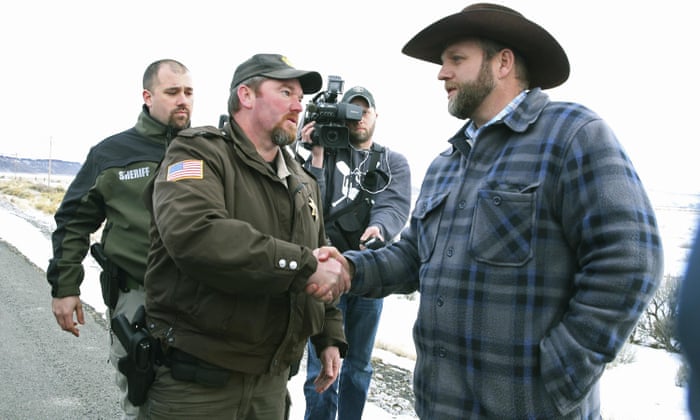
Harney County sheriff Dave Ward meets with Ammon Bundy outside the wildlife refuge: photo by Beth Nakamura/AP, 6 January 2015
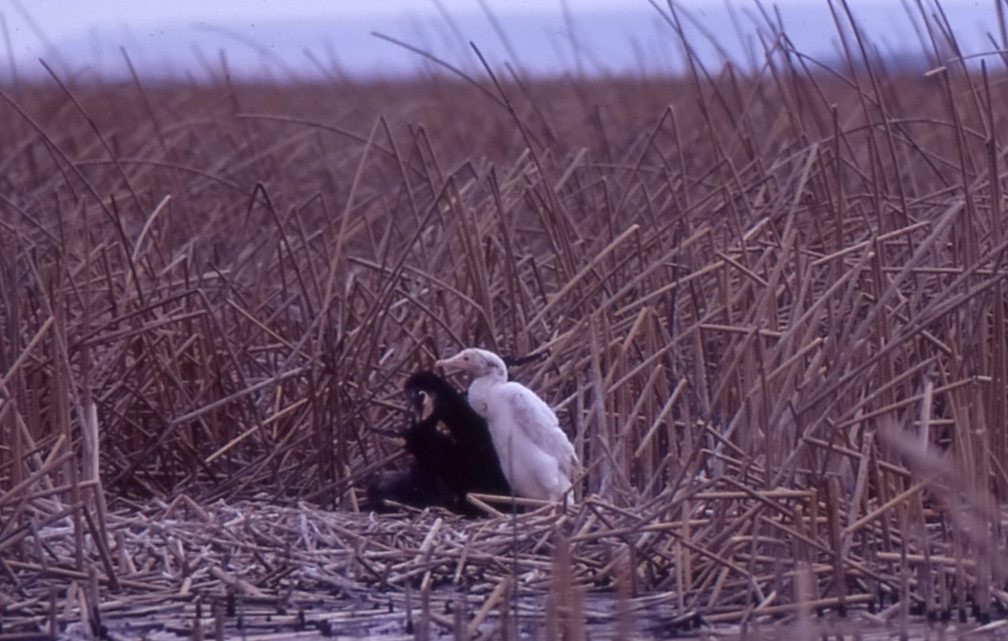
Albino Dark-crested Cormorant (Phelacrocorax auritus) nestlings, Malheur Lake, Malheur National Wildlife Refuge, Oregon: photo by Jon C. Anderson, 16 May 1972

Blackbird, Burns, Oregon: photo by Austin Granger, 22 April 2014
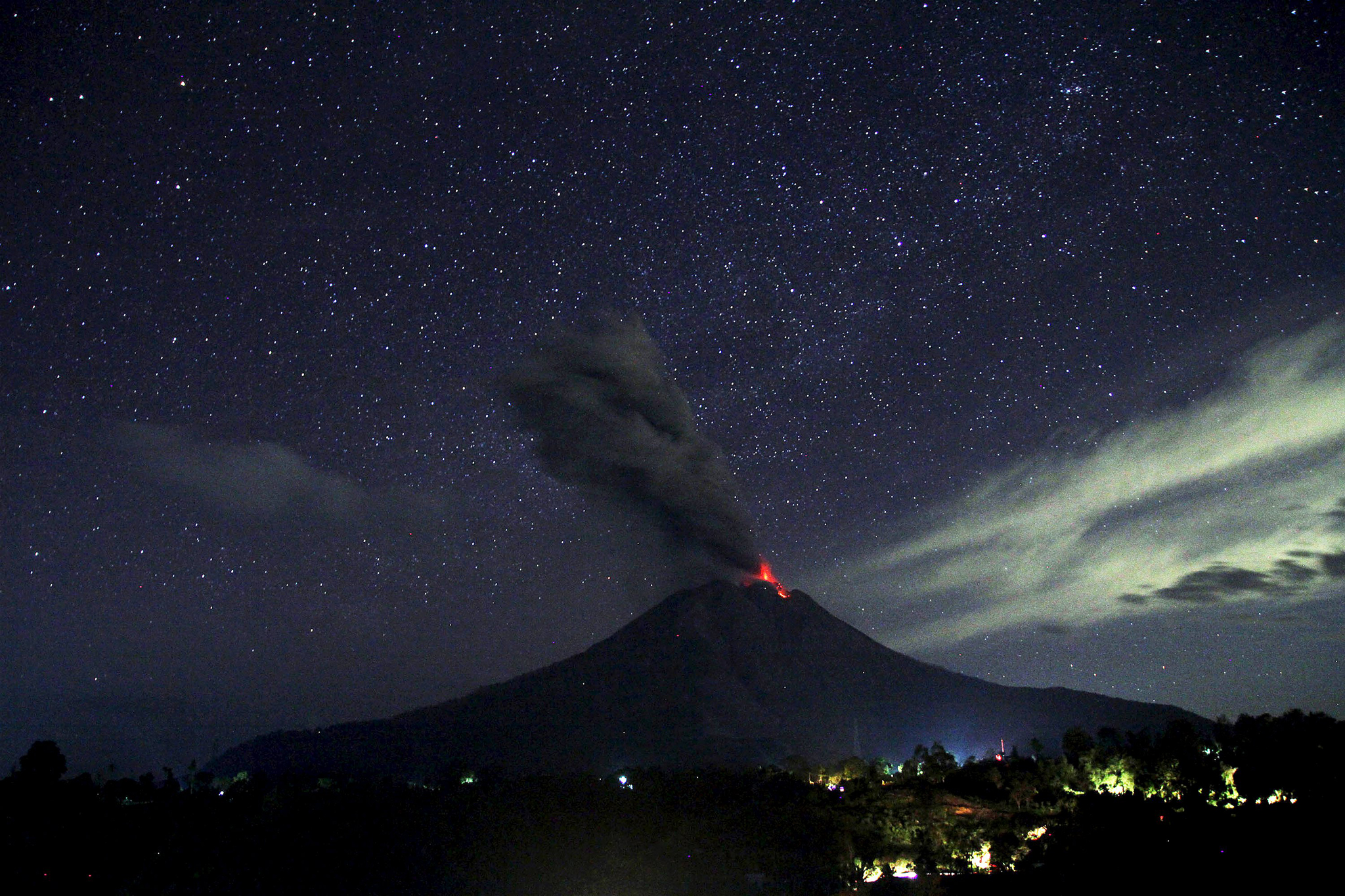







9 comments:
Joe Ceravolo has a great eye for the natural world, and there's a kind of subdued prophetic power to his work. Meanwhile, I wonder if Ammon Bundy has signed his book contract yet or been offered a show on Fox. If he and his fellow terrorists weren't white, they'd be dead or in jail by now.
"while you and I speak under voice
of birds, sleep, mist
at the hour of the street"
love those lines...and the birds...I also wonder about the "hour of the street"...
Tom,
Western Meadowlark, White-faced Ibis, Long-billed Curlew, Tundra Swan, American Avocet, Ross' Geese, Greater Sage-Grouse -- beautiful birds up there in the Malheur, wonder what Bundy and his tribe think about them . . .
I once wrote a poem about the Sandhill Cranes up there, having seen them in great numbers flying overhead, something like this . . .
Blood
The sandhill cranes in
flight like swallows and
other small birds have
learned to rely on
instinct. That is why
when they get up or
rather wheel into
the cold, Canada
dawn knowing South is
neither tundra, tall-
wood nor yellowing
steppe they drive further,
over floating earth,
gorging the air's blood.
Hi Tom
Thanks for posting these. Really made my morning! O
Many thanks to friends for stopping by the Refuge.
Had I been prophetic enough to anticipate Steve's beautiful poem, I'd surely have included the majestic sandhill cranes of Malheur in this small portfolio.
Terry is too right on the point of the double standard whereby the brokeback buccaroos get an ongoing free pass, kind of like a Clipper card without the Clipper and without the charge, whereas, in this and in the previous thousand or so posts on this blog you will find pictures of a few of the hundreds of thousands if not more likely millions of desperate, starving people on the planet who lack homes much less perfectly good ranches of their own, who'd jump (or for that matter leap into a boiling or freezing pit) at the opportunity to move into those great government digs in that vast empty map-patch up in Oregon, eat Mac Cheese and pizza delivered to the sentry at the gate, be interviewed, stomp ceremonially on any endangered migrating birds that happen through the scene, and show off their deformities in a globally televised spectacle of proof for anybody who was still wondering if the appearance of a braindead zombie takeover of America conveyed by media coverage of the Trump "campaign" might possibly be... what? Mistaken impression? Paranoid hallucination?
I think it's fair to say (as Terry has done) that Joe Ceravolo's poems are prophetic. Every day they become more true.
The old eyeballs and wristbones object to being used at all any more, but certain pursuits are worth the pain, especially when the end of the pursuit seems to involve the problem of suffering, of which the end can never be reached, else it would not qualify as a problem, if you get what I mean there, Dwight.
Spend a few hours, and then a few more, looking at pictures of the living creatures of that wildlife refuge, brought back and posted by birders and others of that cast once known as "nature lovers", and then spend a few minutes viewing the visual evidence re the iconic squatter militia.
Militiaman or White-billed Ibis, who's prettier?
Turning public bird refuges and sanctuary marshlands into privately owned cattle grazing ranges would entail making a lot of birds, er, homeless, like they say.
And we know the problems of the homeless qualify as something we don't want to know about, not with all the other more interesting events on the horizon, like the Maxim/Karma International Mondo-Colossal Celebrity Super Bowl Party coming up across the Bay in one minute, and the Armies of the Empires of the Assholes in Suits and Tanks with Guns descending... in fact here they come, quick, hide those damned homeless, throw a tarp over 'em, sink 'em off Treasure Island, whatever you have to do!!
Each of the interesting and (naturally) intensely iconic individual characters in the grand cast of Ammon's Iconic Army of the Righteous Bird-Stompers for God (or AIARBSG, in the nomenclature) has his own story
The porkbelly bodyguard dude with the cheap tats for example, of whom pinups are available all over the net. I did enjoy the one of him dozing peacefully next to a bottle of Bacardi (well, it's actually cradled in his sleeping arm) and a really big gun. It seems this fellow is said to have said or somebody is said to have said to somebody at some point that he was an ex Marine, not to mention massive American patriot, war hero, and so on. Then it came out from another alleger that, hey, he's got a lot more DUI arrests than combat citations.
Then there's Ammon Bundy's brother, another iconic son of the iconic patriot Cliven Bundy, Ryan Bundy, the Bundy brother with the "asymmetric face".
But all this heady research is aggravating the migraine it has already caused. I've got to go bang on my Bible and then on my copy of the Constitution for a bit.
Oregon militia stand their ground but local residents want 'these thugs' gone: As the armed militia – many traveling from out of the state – flock to and transform the Malheur wildlife refuge into a tight-knit community, on the outside a growing chorus of locals grow wary: The Guardian, 8 January 2016
Today's update suggests that every heavily armed wingnut in this fair land who is not yet camping at taxpayer expense on the iconic patriot picnic grounds is on the way. And it seems the iconic party animals have been the recipients of massive largesse from "supporters", so that their freezers are now bulging with enough food to feed a whole American city for a solid week -- or Aleppo, say, for the next five years.
"With no police presence or threats of arrest and a growing number of anti-government activists visiting the refuge, the occupation by the end of the week had devolved into something of a chaotic free-for-all. Reporters and curious residents and ranchers mingled with armed militiamen – some of whom had their wives, children and grandchildren visit them on Friday. For the most part, there was little order or organization – other than Jon Ritzheimer, an anti-Islam activist and de facto guard occasionally blocking media from entering. People walked freely into government administrative offices, a wildlife museum and other federal buildings. Militia members and media could leave and return to the refuge at any time, making it clear that the occupation won’t end due to a lack of food. Cooper showed the Guardian that the group on Friday afternoon had four freezers filled with meat and so many piles of donated goods from supporters that it was a daunting task to organize."
You never know what's going to happen next in a free country, so if you don't like it, go found your own, just so long as it's not anywhere near Earth.
Just when we thought the Oregon Occupiers were occupied -- with holding the press briefings, polishing off the donated victuals, having fun driving the big backhoe and dozers and other heavy equipment all round the wildlife refuge site, ripping down the federal signage at the facility and replacing it with a notice identifying the place as the Fred Flintstone Memorial American Patriot Resource Center (Pacific Peckerwood Branch), and so on -- right in the midst of all this larking about and posing for pictures, what should roll up in a cloud of icy steam across the frozen high desert wasteland but an actual military-style convoy of eighteen armoured vehicles, which pulled up at the Refuge, and issued forth a detachment of heavily armed high-grade amerikan kretins ("Long Gun" types), who promptly declared their intent to "offer security" -- "de-escalate" is the term they used. (I believe the wingnut factions are now experimenting with a special code language in which anything said should be taken to mean its opposite.) These latest arrivistes seem in the photos to be attempting to project an aura of deep menace, but the one guy most photographed, though he's got enough weaponry on his person to protect a bear from a panting Lenny diCaprio, is in fact a spitting image of the movie actor Wilfred Brimley, an ex-Marine Mormon cockfighting advocate best known for playing the grumpy, portly, bumbling retirement-home resident whose next door neighbors are aliens from Antares, in the film Cocoon.
(Come to think of it, maybe not such a bad casting choice for a wingnut-convoy volunteer road-crossing guard, after all.)
But alas, that iconic yet ungrateful gang, the Bundy Bunch said No thanks, we've got our own guns.
And the Long Gun volunteers had to haul ass back into their militarized pickups and sport utility vehicles and make chain-tracks away across the blank Tundra whence they'd come.
I'm not even kidding.
More armed men visit site of Oregon wildlife refuge standoff: AP, 9 January 2016
ay-yi-yi to your last comment Tom and once again many thanks for the poetry and photo juxtapositions that summarize the current predicament of all creatures in the face of human ignorance, willful or not...
Michael,
Can it be that... or what if... Manifest Destiny wandered out of the hut in a blizzard... or a delirium... after chewing too much high-sodium jerky... got lost in the permafrost... and ran for President... against Lena Dunham... and won!
Post a Comment